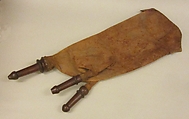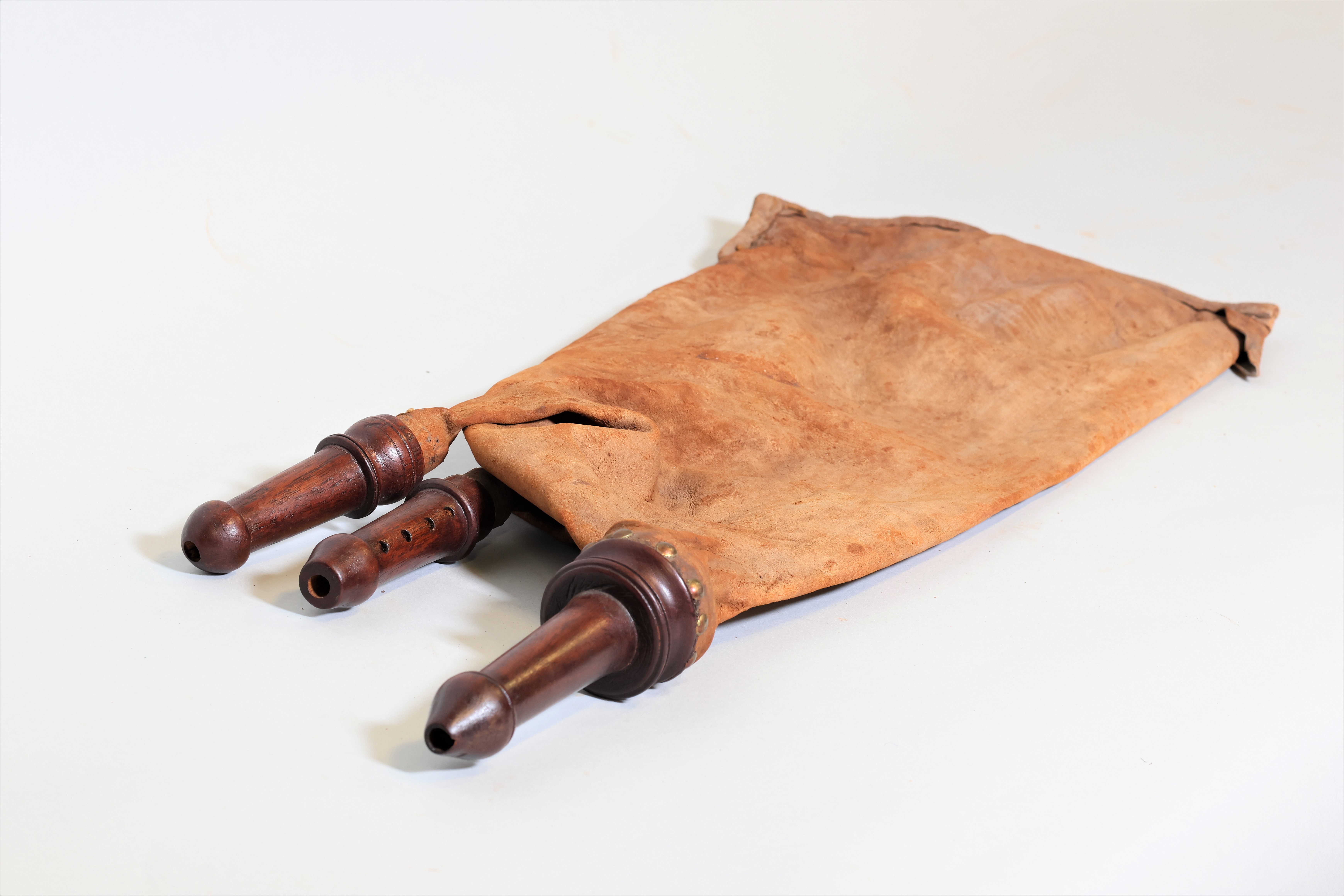Zitty (Bagpipe)
Not on view
This bagpipe was sent from Calcutta to New York in December 1902 by Gillanders, Arbuthnot & Co., a management agency that also acted as a sales agent (Misra 1999:22), and arrived in New York on 9th March 1903. The instrument was identified as a ‘Zitty or Bagpipe’ on the invoice, and cost 20 rupee (Met Museum Archives). The denomination ‘Zitty’ is close to the word ‘Titti’, a documented name for bagpipes in Andhra Pradesh (Roghair 1982:33).
The titti, or sruti upanga, is a bagpipe that was historically played throughout Southern and Central India (Day 1891, Sonnerat 1782:102). This bagpipe – also called bhazana sruti (Day 1891:Plate XVI), titti in Andhra Pradesh (Roghair 1982:33), or tourti (Sonnerat 1782:102) – was played in a range of settingsBagpipes are also present in Northern India. These instruments, called moshuq, mashak, or mashaq bin (bag instrument) (Cooke 1987), are played in temple settings by bhopas who serve a deity. They have a parallel chanter and drone, which are inserted in a wooden sleeve and fixed with black wax. The melodic pipe is generally played with one hand, using all four fingers.
This instrument may be an interpretation of an Indian bagpipe, or an innovative version of it. Indeed, this instrument does not resemble vernacular bagpipes found in Andhra Pradesh, Chennai (formerly known as Madras), nor Northern Rajasthan. It has a sewn leather bag and turned pipes. Vernacular Indian bagpipes were made out of goat skins, rather than sewn leather, the forelegs of which were fitted with a reed blowpipe and a drone or chanter. While turned insufflation pipes are present on North Indian bagpipes (the mashak), the melodic pipe and drone are parallel pipes encased in a wooden sleeve. Here, the presence of a drone in addition to a separate melodic pipe is unusual; however, the four fingerholes found on the melodic pipe matches the use of bagpipes found in Northern Rajasthan (Cooke 1987), where musicians play with one hand and use the other to cup the end of the melodic pipe in order to hear the sound better (Cooke, email comm., 2019). While this bag still makes use of the goat features (the forelegs and the neck are fitted with a drone, an insufflation pipe and a melodic pipe), the back of the bag is not traditionally tied, but is sewn with an additional folded leather seam. This unusual bag (also found on instrument 89.4.263) could be interpreted as an innovation taken from Highland bagpipe bags, made out of tanned leather sewn into the desired shape. The separate drone and melodic pipe could also be influenced by the Western instrument, that already had a strong presence throughout the Indian territory through its military use.
(Cassandre Balosso-Bardin, 2023)
Technical Description
Reddish wood pipes.
Single wooden chanter with cylindrical bore, 121 mm.
One wooden short drone, 120 mm.
Cylindrical wooden insufflation pipe with round base, no valve, protruding 145 mm.
Leather (sheepskin?) bag approx. 640 mm. long, hind end sewn with attached partial welt, neck and forelegs holding pipes.
References
Cooke, Peter, 1897. ‘Bagpipes in India’, Interarts.
Cooke, Peter, 2019. Email communication. Instrument file 89.4.2938. Metropolitan Museum or Art Archives.
Day, Charles Russell, 1891. The music and musical instruments of southern India and the Deccan. London & New York: Novello.
Misra, Maria, 1999. Business, Race, and Politics in British India c.1859-1960. Oxford: Clarendon Press.
Roghair, Gene. H. 1982. The Epic of Palnadu: a sturdy of Palnati Virula Katha, a Telagu Oral Traditional from Andhra Pradesh, India. Oxford: Clarendon Press.
Sonnerat, Pierre, 1782. Voyage aux Indes orientales et à la Chine. Tome premier. Chez l’Auteur
Due to rights restrictions, this image cannot be enlarged, viewed at full screen, or downloaded.
This artwork is meant to be viewed from right to left. Scroll left to view more.


.jpg)
.jpg)
.jpg)
.jpg)
.jpg)


